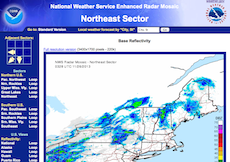The New York Times | Weather.com
As a winter storm cuts its way through the South and lumbers closer to the East Coast this week, it’s a wise newsroom that’s planning not just for a severe weather story but also for an emergency that could stop its presses or take down its website.
As of Monday night, forecasters expected the storm to bring rain, ice and snow to the South, with two to four inches of rain predicted for eastern cities beginning Wednesday. Airports from Boston to Washington, D.C., may be hardest hit, but the storm could also complicate holiday driving, the National Weather Service said.
Travelers in the East may see the effects of the storm as early as today, according to the Times. The timing, as they say, could not have been worse:
The inclement weather comes as millions of people take to the air and roads for the Thanksgiving holiday. More than 40 million people are expected to drive or fly at least 50 miles for Thanksgiving, with Wednesday expected to be the single busiest day, according to the AAA, the automobile association.
So what’s a newsroom to do? Complete all of the preparations that you would make for yourself and your family: have the staff fill up their gas tanks, set side some extra cash, and think through contingencies.
Emergency supplies should be taken out of storage and checked to ensure they are in working order. Batteries for flashlights and lanterns, windup cell-phone chargers, car chargers, adapters for laptops, extra water and food and rain jackets should all be ready to go. Keep journalists who will be out in the field stocked with equipment and supplies and test their backup communication systems.
Among the resources to consult for both stories and preparations:
• Federal Emergency Management Administration’s Ready.gov website offers advice on preparing for winter storms and severe weather.
• The American Red Cross provides winter-storm preparation advice, emergency-kit lists, and tips for keeping safe during a storm and protecting pets.
• The California Energy Commission has tips for businesses in the event of a power outage, while Portland General Pacific offers a brochure for businesses that provides a quick checklist, even if you aren’t in their coverage area.
While this week’s storm is no Hurricane Sandy, the superstorm that devastated parts of the Eastern seaboard in October 2012 provided useful and replicable examples of storm coverage that went beyond the ordinary.
Significantly, several media outlets dropped their paywalls during Hurricane Sandy allowing readers to access important coverage of the massive storm. And they did it again in February when a severe winter storm pummeled the Northeast.
Sandy also produced fake photos and efforts to debunk misinformation, and that’s something to keep in mind for the coming storm coverage.






